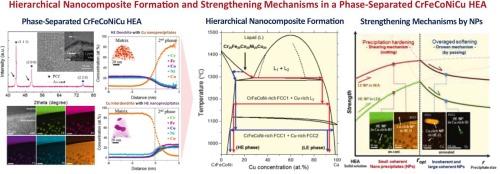相分离CrFeCoNiCu高熵合金中层次化纳米复合材料的形成及强化机制
IF 7.9
2区 材料科学
Q1 MATERIALS SCIENCE, MULTIDISCIPLINARY
引用次数: 0
摘要
本研究研究了一种CrFeCoNiCu高熵合金(HEA),在混相间隙和单晶反应的驱动下,表现出富cu低熵区(LE)和富crfeconni高熵区(HE)的分层相分离。基于calphad的伪二元图指导了凝固和退火条件的优化,促进了每个相内纳米级相干沉淀(NCP)的形成。多尺度分析(SEM, EPMA, TEM, 3D APT)揭示了双fcc相复合物,其中每个区域包含另一相的ncp。在退火过程中,次级ncp比初级相分离区域生长得更慢,从而可以通过热处理进行有效控制。通过纳米压痕和微柱压缩进行的力学测试表明,相干ncp通过剪切机制提高了强度。特别是,HE基体中的LE ncp有效地分布了外加应变,抑制了位错运动和滑移带的形成,导致了稳定的应变硬化,没有应力下降。当粗化超过适用于剪切的尺寸时,过渡到Orowan旁路机制,导致纳米硬度降低。这些发现强调了相干相分离纳米结构在强化和变形控制方面的重要性,并提出了一种热动力学指导的微结构设计策略,用于制造具有可调机械性能的hea基分层纳米复合材料,为开发下一代高强度、延展性结构材料提供了一种有希望的方法。本文章由计算机程序翻译,如有差异,请以英文原文为准。

Hierarchical nanocomposite formation and strengthening mechanisms in a phase-separated CrFeCoNiCu high-entropy alloy
This study investigates a CrFeCoNiCu high-entropy alloy (HEA) exhibiting hierarchical phase separation into Cu-rich low-entropy (LE) and CrFeCoNi-rich high-entropy (HE) regions, driven by a miscibility gap and monotectic reaction. A CALPHAD-based pseudo-binary diagram guided the optimization of solidification and annealing conditions, promoting nanoscale coherent precipitate (NCP) formation within each phase. Multiscale analysis (SEM, EPMA, TEM, 3D APT) revealed a dual FCC-phase composite where each region contains NCPs of the other phase. During annealing, secondary NCPs grow more slowly than primary phase-separated regions, enabling effective control through heat treatment. Mechanical testing via nanoindentation and micropillar compression showed that coherent NCPs enhance strength via a shearing mechanism. In particular, LE NCPs in the HE matrix effectively distribute the applied strain and suppress dislocation motion and slip band formation, resulting in stable strain hardening without stress drops. Upon coarsening beyond the size applicable for shearing, transition to the Orowan bypass mechanism resulting in a decrease in nano-hardness. These findings highlight the importance of coherent phase-separated nanostructures in strengthening and deformation control, and present a thermodynamically guided microstructural design strategy for fabricating HEA-based hierarchical nanocomposites with tunable mechanical performance, offering a promising approach for developing next-generation high-strength, ductile structural materials.
求助全文
通过发布文献求助,成功后即可免费获取论文全文。
去求助
来源期刊

Materials & Design
Engineering-Mechanical Engineering
CiteScore
14.30
自引率
7.10%
发文量
1028
审稿时长
85 days
期刊介绍:
Materials and Design is a multi-disciplinary journal that publishes original research reports, review articles, and express communications. The journal focuses on studying the structure and properties of inorganic and organic materials, advancements in synthesis, processing, characterization, and testing, the design of materials and engineering systems, and their applications in technology. It aims to bring together various aspects of materials science, engineering, physics, and chemistry.
The journal explores themes ranging from materials to design and aims to reveal the connections between natural and artificial materials, as well as experiment and modeling. Manuscripts submitted to Materials and Design should contain elements of discovery and surprise, as they often contribute new insights into the architecture and function of matter.
 求助内容:
求助内容: 应助结果提醒方式:
应助结果提醒方式:


